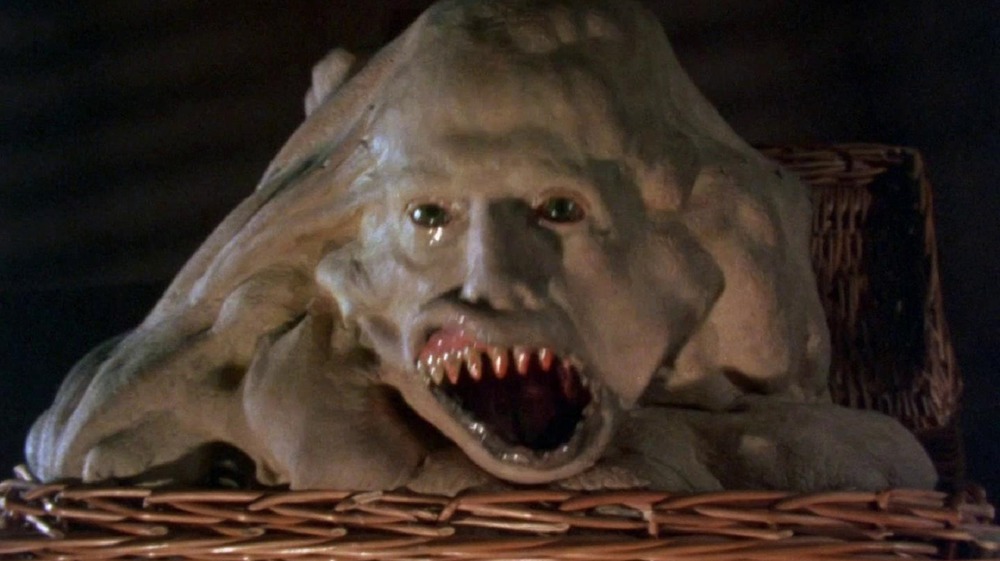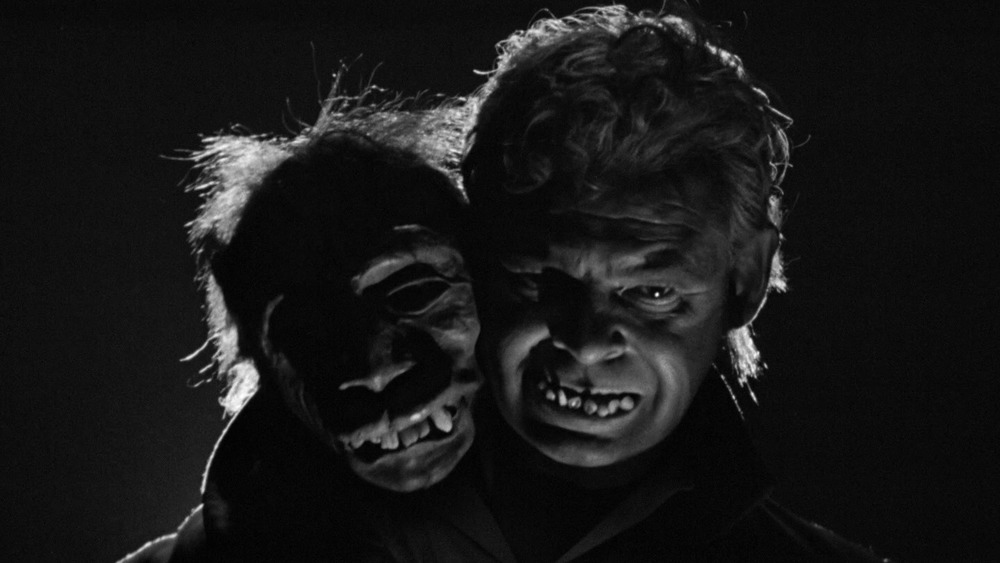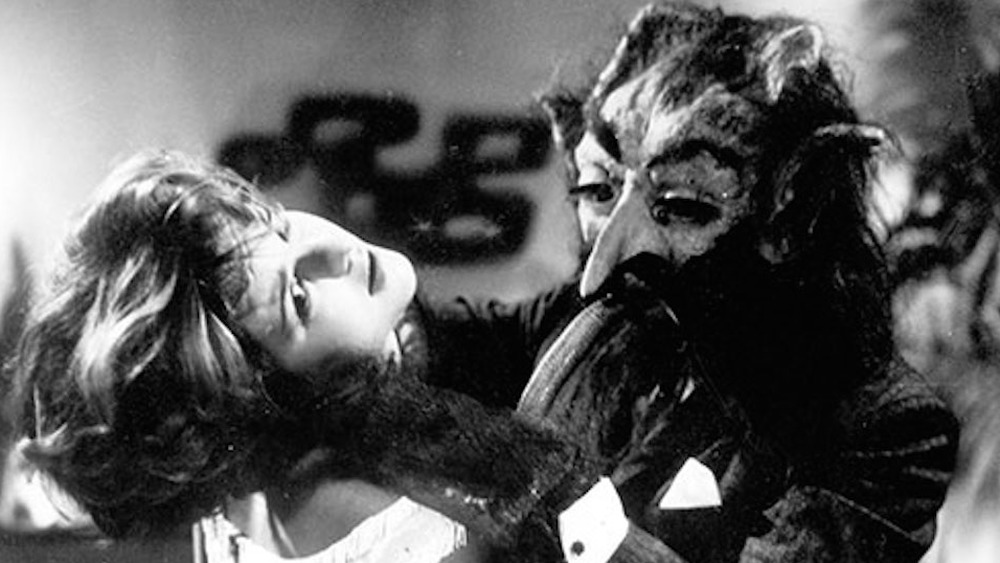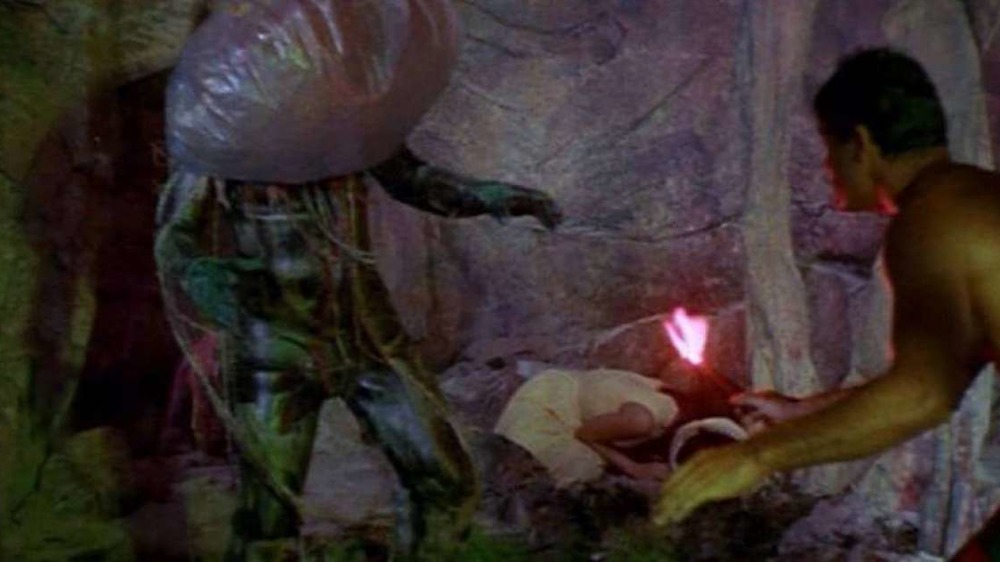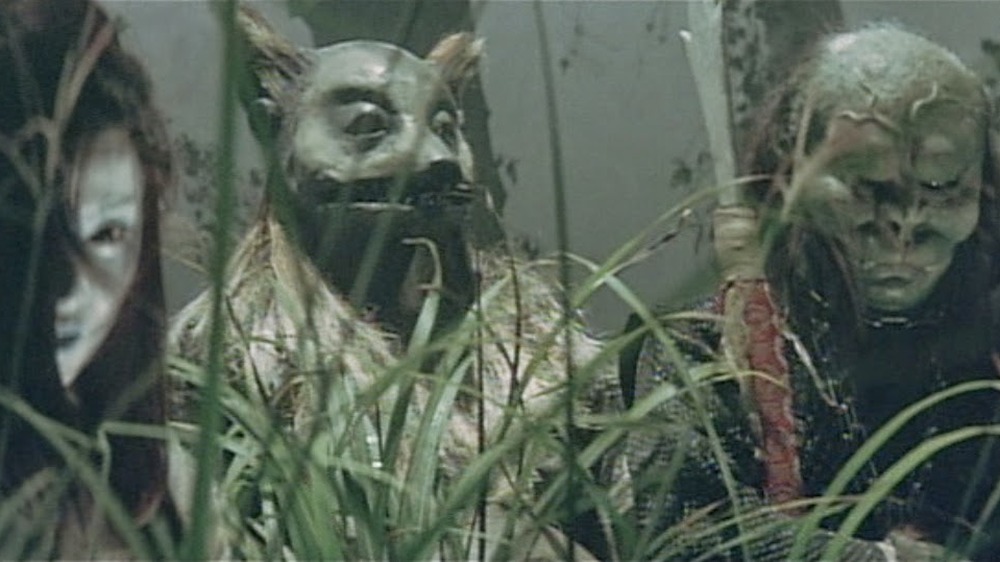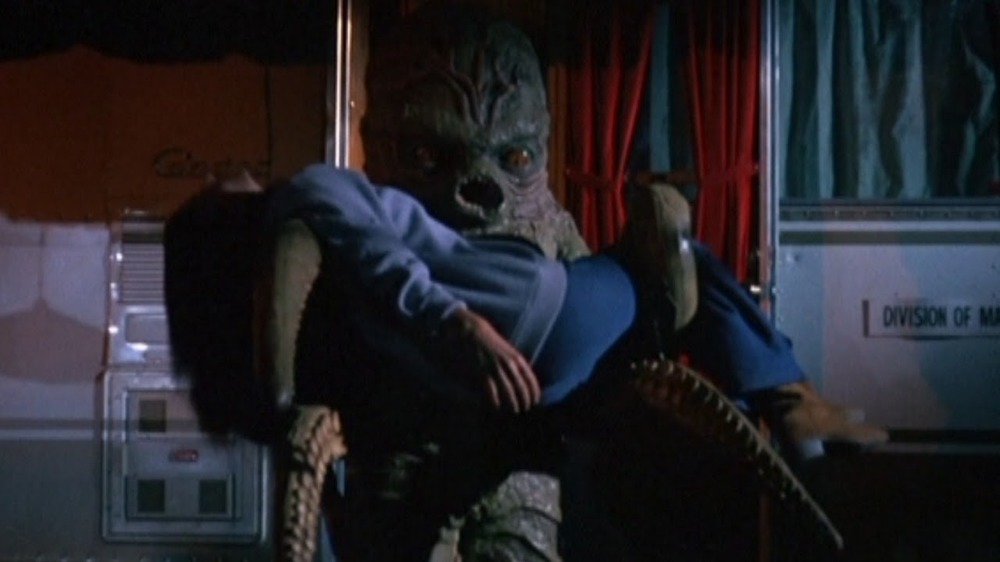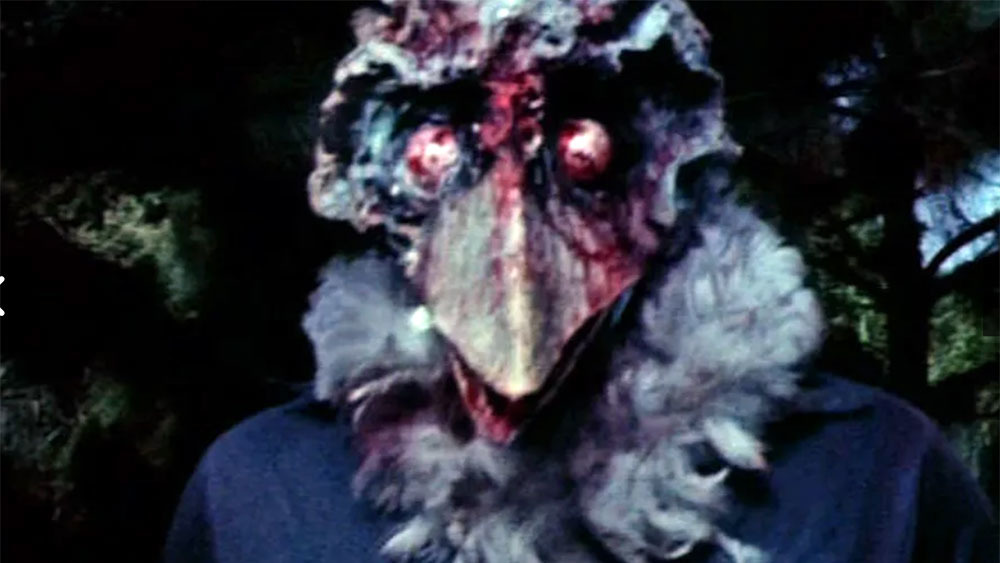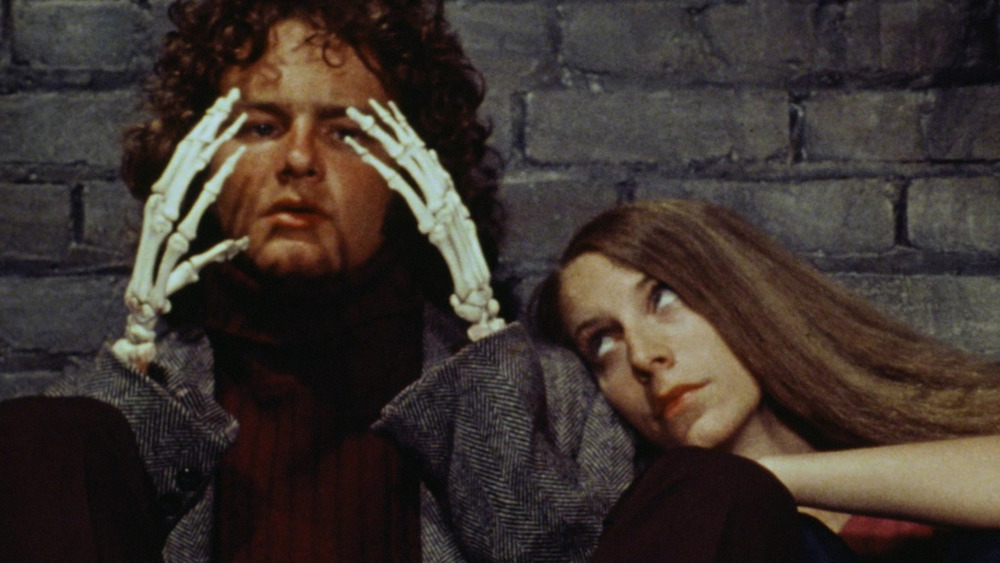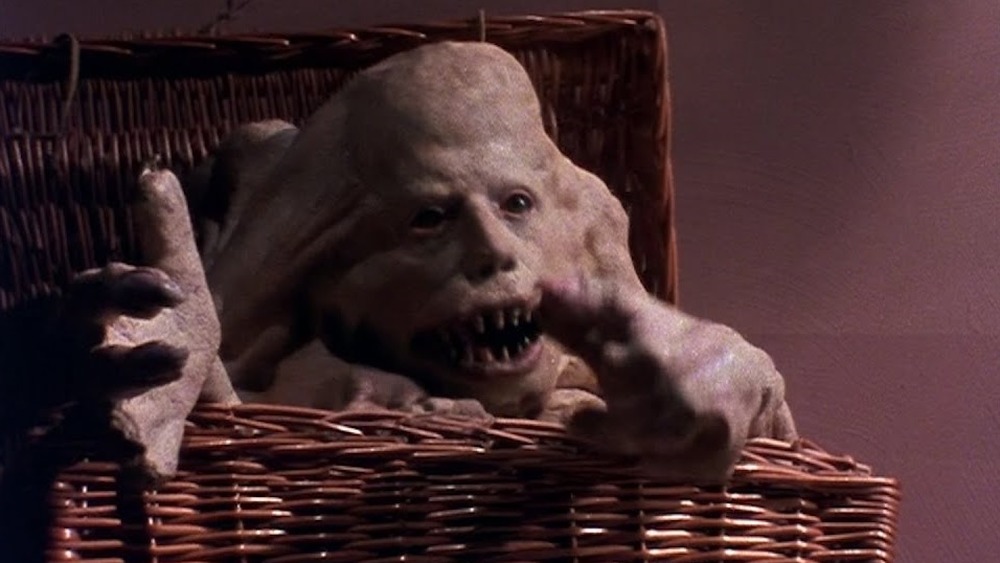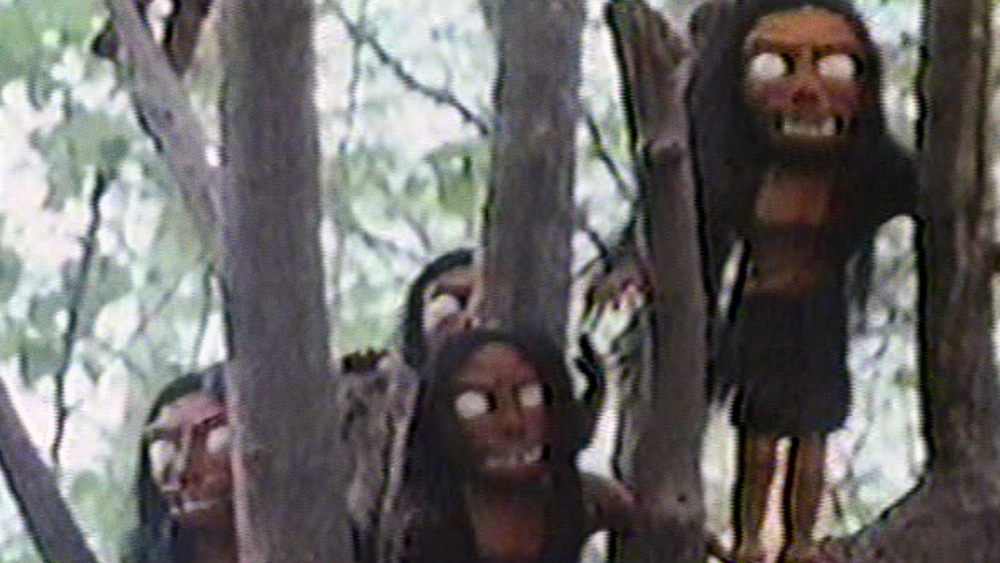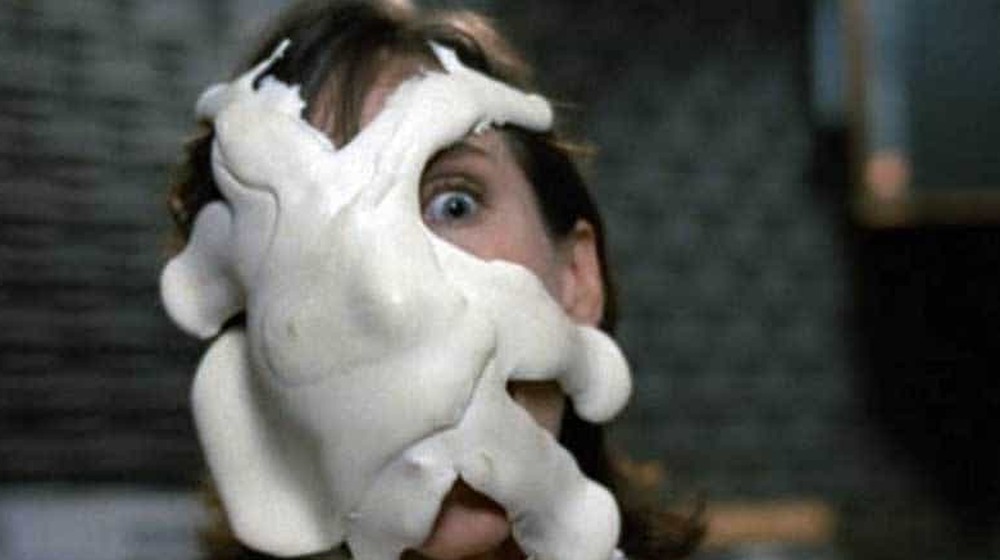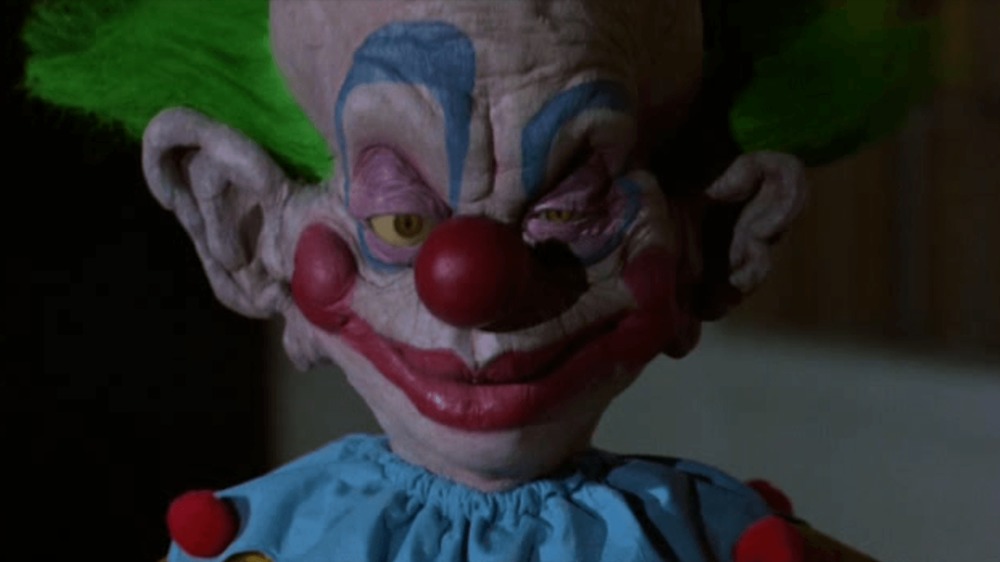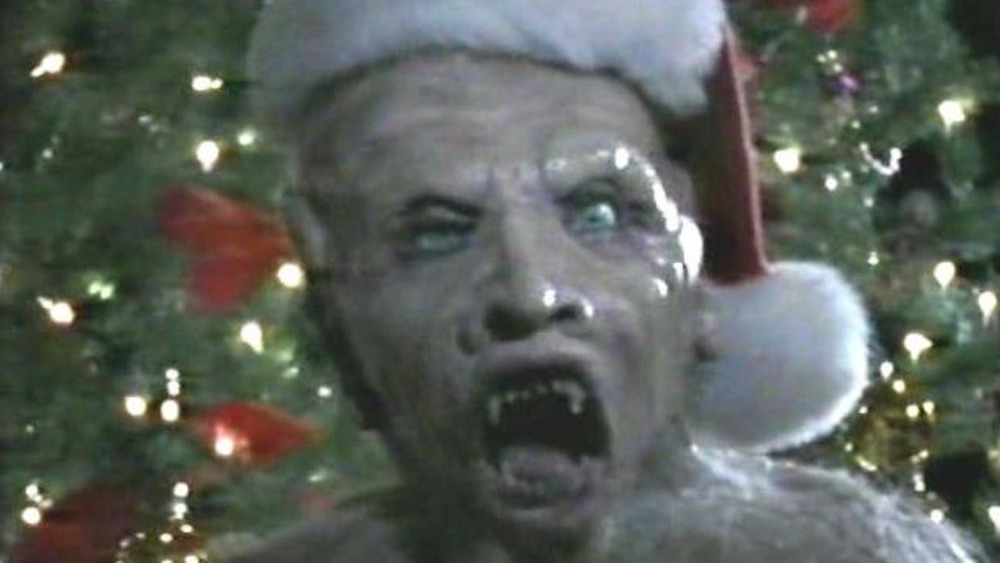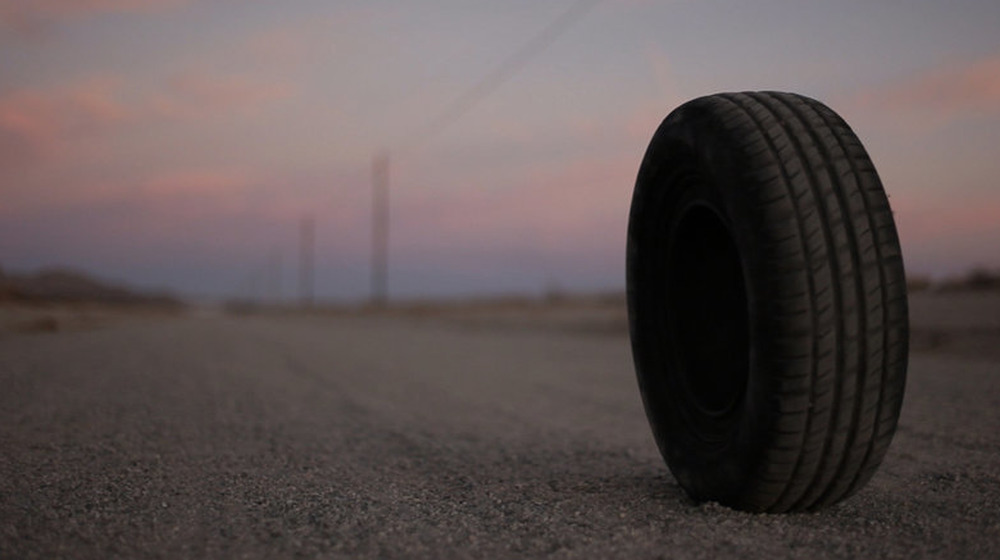The Weirdest Movie Monsters In Horror Film History
A monster, by definition, is already something weird — a being or entity that not only defies category or description but also evokes confusion and terror by its mere presence. And as the past century-plus of horror movies has shown us, monsters cone in many forms: alien, prehistoric, supernatural, and even human.
But some monsters defy all expectation by virtue of appearance or intent. Sometimes that's the result of wild imagination, and sometimes it's the inventive (or unusual) solution to a budgetary problem. In those cases, what results is a movie monster that lingers in our memory –- for better or worse — because it's just so unlike anything we've seen before, and most likely, will ever see again.
Following are some of the strangest creatures ever to lurch across movie screens in the history of horror movies, both from the United States and from countries across the globe. Don't say you haven't been warned. (Warning — there are spoilers below.)
The Manster proves that two heads are weirder than one
A round of drinks with a scientist (Tetsu Nakamura) gives journalist Larry Stanford (Peter Dyneley) more than just a hangover. The scientist has dosed him with an experimental evolutionary drug that first spurs homicidal urges in Stanford before eventually manifesting as a fanged second head that sprouts from his shoulder!
The Manster, a 1959 American feature made on location in Japan by former child actor George Breakston and editor Kenneth Crane, walks a fine line between creepy and cartoonish. Several of the murders, especially one that takes place in a shrine, are effectively filmed and eerie, but any tension or atmosphere is largely undone by the special effects, especially that second head, which bobbles on Peter Dyneley's shoulder like a Halloween mask on a floppy balloon.
However, the go-for-broke finale, which finds man and monster literally ripping in half (a scene echoed decades later in Sam Raimi's Army of Darkness) before frantically wrestling on the edge of an active volcano, more than makes up for any shortcomings.
The Brainiac: He's just dying to eat you
Decades before the zombies in Return of the Living Dead snacked on human brains, another monster displayed an appetite for that particular organ in one of the strangest horror movies to come out of Mexico.
The Brainiac –- released in 1962 as El Baron del Terror (The Baron of Terror), and no relation to the DC Comics villain –- concerns a nobleman (veteran Mexican actor Abel Salazar, who's also the film's producer) who, prior to his execution for witchcraft in 1661, promises to return when a comet passing overhead next orbits Earth. Flash-forward to 1961, when said comet deposits Salazar on our planet, but now he's equipped to transform into an ugly monster with a forked tongue that he uses to suck out the brains of his victims!
The monster makeup is unquestionably among the most outrageous ever featured in a horror film, Mexican or otherwise. In Brainiac form, the Baron resembles the Devil after a two-day bender, with a long, beak-like nose, severe sideburns sprouting from a receding hairline, and grabby hands with two pincer-like figures. When not draining his immediate victims, the Baron also keeps a spare brain in a box, from which he occasionally nibbles with a long spoon while in human form.
Beware the jellyfish monster in Sting of Death
Florida is home to several creatures around which an enterprising producer might build a horror film — alligators, snakes, fire ants, sharks, and even panthers. The Portuguese man o' war can also be found in the waters off the Sunshine State, and while its stinging tentacles are extremely painful, it's generally not a threat to humans. Furthermore, its ungainly shape, which resembles a more florid version of its relative, the jellyfish, is alarming but doesn't exactly inspire terror.
Yet 1966's Sting of Death banks on the notion that we might find a huge man o' war scary, and that we'd consider a half-man, half-man o' war positively terrifying. That might be the case, but Sting –- directed by veteran Florida filmmaker William Grefe, who oversaw the underwater shark sequence in Live and Let Die –- offers up an actor covered in goop and sporting what appears to be a large Mylar balloon with slimy streamers over his head, which provokes more concern for his safety than abject fear. In an attempt to perhaps deflect our fears for the well-being of the jellyfish monster, Grefe also gives us lots of Florida teens dancing to Neil Sedaka singing "Do the Jellyfish."
Yokai Monsters: 100 creatures and counting
If you're a fan of the phantasmagoric world of Japan's yokai, or supernatural creatures, you owe it to yourself to seek out the Yokai Monsters trilogy. Produced by the Daiei Film Company (the studio that oversaw the Gamera series), the three films in the loosely connected trilogy — 1968's 100 Monsters and Spook Warfare and 1969's Along with Ghosts –- all focus on clashes between the human and spirit world, which are usually under dire conditions, like a businessman attempting to tear down a village shrine in 100 Monsters.
But the premise isn't what makes the Yokai films so much fun for creature feature fans. Instead, it's the parade of outrageous monsters that populate each picture. Among the most eye-popping examples, there's the kappa, a lizard-like water demon with a depression on top of its head that contains its life-giving water, and a variation on the futakuchi-onna, or "two-mouthed woman," which hides a ravenous second mouth on the back of its head. Plus, we've got the rokurokubi, which can extend its neck like a tentacle, and there's also the kasa-obake (or karakasa kozo), a living umbrella with a long, lolling tongue.
Daiei's use of practical special effects, including puppetry and suitmation, won Yokai Monsters a devoted following in Japan, including cult powerhouse Takashi Miike, who directed his own yokai movie, The Great Yokai War, in 2005.
Octaman is no Creature from the Black Lagoon
A scientific expedition to a remote jungle, the discovery of a half-man, half-aquatic creature with amorous designs on a female member of the research team –- sound familiar? But it's not Creature from the Black Lagoon that's under consideration here, but instead, it's 1971's Octaman, the brainchild of writer-director Harry Essex, who was the co-writer of Creature.
Octaman essentially follows the plot of its predecessor, though its monster –- a pudgy, scowling humanoid octopus that walks on two of its six tentacles (and yes, that would make it a hexapus) -– doesn't inspire the same degree of awe and pathos as the Gill-man. However, the creature's pedigree is impressive. Actor/stuntman Read Morgan wore a suit that was constructed from polyfoam -– the material used to make mattresses and insulation — and liquid latex by two future special effects legends: seven-time Oscar winner Rick Baker (An American Werewolf in London) and Doug Beswick, whose credits include The Empire Strikes Back, Aliens, and Evil Dead II.
Be thankful there's only one Blood Freak
It may surprise you to learn that 1972's Blood Freak isn't the only movie about a monster turkey. The 2008 indie ThanksKilling features a homicidal turkey demon slaughtering college kids. But Blood Freak offers not only a man with an enormous turkey's head but one addicted to both marijuana and blood-drinking! It also manages to wedge weird science and religion into its running time.
Suffice it to say that biker Herschell (played by movie muscleman Steve Hawkes) follows a complicated road over the course of the film, and one that somehow takes him from hippie smokefests to a turkey farm. It's there that two researchers feed him experimental drugs that give him a giant, immobile turkey head (that ceaselessly gobbles) and a thirst for blood. Only the power of prayer, courtesy of a comely hitchhiker, saves him from both the hell of addiction and the Thanksgiving Day dinner table. Director Brad F. Grinter –- a prolific Florida-based exploitation filmmaker –- occasionally pops up to offer elliptical commentary before being silenced by a seemingly real coughing fit.
Death Bed: The Bed That Eats ... it's exactly what you think it is
Everything you need to know about this 1977 oddity is summed up in its title ... or is it? Yes, Death Bed: The Bed That Eats does indeed detail a berth with an appetite for those unlucky to catch a few winks on it. But the film — written, produced, and directed by George Barry and unseen until the early 2000s — weaves a complicated supernatural element into the plotline. A demon accidentally kills a human woman while attempting to consummate his affection for her, and his tears of blood bring the bed to life, albeit with the need to devour anyone unlucky enough to use it.
The English illustrator Aubrey Beardsley is also somehow involved in the whole affair. It's suggested that he's trapped in a painting and forced to observe and comment on the bed's dining habits. Regardless, in a movie called Death Bed: The Bed That Eats, you've come to see the promise of the title fulfilled, and Barry does just that –- in portmanteau form, no less –- before the whole freaky affair comes full circle. Or does it? Yeah, it does.
Basket Case is a horror movie about brotherly love gone wrong
As the tagline on the one-sheet for 1982's Basket Case reads, "The tenant in Room 7 is very small, very twisted, and very mad." Said tenant is Belial, the profoundly disabled and certifiably insane conjoined twin of mild-mannered Duane Bradley (Kevin Van Hentenryck). Years ago, a trio of doctors separated the pair against their will, and now, the two have taken up residence in a seedy Time Square hotel where they plot their revenge.
Delivering gallons of gore and bad taste is the primary goal of Basket Case, but there's also a surprising amount of raw emotion in writer-director Frank Henenlotter's film debut. Belial may be a lumpy, jabbering puppet, but Henenlotter's script allows it to express a considerable amount of pain, anger, frustration, and jealousy ... while also dismembering anyone unlucky enough to peek inside the wicker basket in which it resides. A favorite among the grindhouse faithful, Belial returned for two sequels, 1990's Basket Case 2 and 1991's Basket Case 3: The Progeny, which saw him becoming a proud papa.
Attack of the Beast Creatures isn't playing around
If you wanted to see a horror movie about shipwreck survivors encountering something horrible on a deserted island, what might you hope that monster to be? A giant animal? Zombies? Cannibals? How about dolls? Tiny, sharp-toothed, blank-eyed dolls with hippie hairdos?
If your answer is yes to this last choice, then look no further than 1985's Attack of the Beast Creatures, a microbudget chiller filmed entirely in the wilds of Stanford, Connecticut. It's a movie that pits the survivors of a cruise ship disaster in 1920 (yes, it's also a period film) against the toy-sized inhabitants of a deserted island. Since the beast creatures are, in fact, toys, the filmmakers are required to hurl them at the amateur cast in order to approximate any sense of menace.
Though many of the cast members are dispatched in this manner, a few brave souls determine the best way to fight back — they just pick up the creatures and hurl them out of the frame. Because they're toys.
The Stuff is a deliciously weird horror movie
In his horror and science fiction efforts, the prolific writer-director Larry Cohen seemed to specialize in unique and outrageous monsters. There was a mutant baby in It's Alive, a flying dinosaur god in Q, and a hermaphrodite alien with psychic abilities in God Told Me To. One of his lesser-known but equally offbeat creatures is front and center in 1985's The Stuff, and it's not only terrifying, but it's also delicious.
Marketed as a no-calorie dessert, the yogurt-like Stuff develops a diehard following among consumers, who discover far too late that the treat is actually a living organism that takes over their brain and then their bodies before exuding itself, soft serve-style, from all available orifices. As with Cohen's other films, The Stuff works as both skewed satire –- rampant consumerism and ruthless big business are the targets here –- and gonzo genre film. Its eccentric cast is also a key selling point. Where else are you going to see Saturday Night Live vet Garrett Morris and, in uncredited cameos, Mira Sorvino, Patrick Dempsey, and Eric Bogosian in the same film?
Killer Klowns is still the king of weird movie monsters
For many viewers, the phrase "weird monsters" conjures up a single film, the 1988 horror-science fiction-comedy favorite Killer Klowns from Outer Space. The Chiodo brothers — who handle writing, producing, direction, special effects and makeup — hang their film on a premise that's both outrageous and, in its own bizarre way, somewhat believable. If aliens intent on conquering the Earth wanted to both disarm and terrify us at the same time, why not choose to resemble oversized clowns?
In that regard, the Klowns are totally successful creations, evoking both horror and hilarity with not only their appearance but also their array of Klown tech. The popcorn parasites, cotton candy cocoons, and blood-draining Krazy straws are as inspired as they are unsettling. Plenty of deliberately "bad" or cult-minded horror films have tried to strike a similar blend of weird and wacky, but Klown-heads know that when it comes to weird, there's only one ringmaster: Killer Klowns from Outer Space.
Elves is no holly, jolly Christmas movie
There are complicated and convoluted origin stories for movie monsters, and there's 1989's Elves. The direct-to-video Christmas chiller asks viewers to wrap their minds around the idea that elves -– the small, cheery assistants to Santa Claus, not the Lord of the Rings variation -– are actually demonic creatures linked to Adolf Hitler. As it turns out, the Nazi sought to take over the world by crossbreeding the monsters with pure-blooded Aryans.
This information becomes of vital importance to sullen teen Kirsten (Julie Austin) when she revives a monster elf during a pagan ritual, and then discovers that her grandfather is not only her father but also a neo-Nazi with designs on reviving Hitler's elf program ... with her as the human part of the breeding equation. The only thing standing between Christmas and this avalanche of bad taste is former TV star Dan Haggerty as an alcoholic cop turned department store Santa, who undoubtedly thanked the film's producers for lacking the funds to create more than one stiff-faced rubber elf for him to battle in the finale.
When the Rubber hits the road, it's murder
In 2010's Rubber, a car tire named Robert becomes, for reasons known only to writer-director Quentin Dupieux, a sentient being and also something of a psychopath after discovering that it possesses the ability to make things explode at will. And for much of the film's running time, Robert does just that, blithely picking off lonely souls he encounters while rolling through an unremarkable stretch of California desert.
There are also frequent cutaways to an audience (who are also in the desert) who've gathered to watch a movie about Robert's misadventures and, on occasion, participate in it. Both the events that take place in Rubber and the meta-moviegoers watching those events unfold collide, more or less, in the film's two conclusions, which seem to either applaud or decry (or both) the artifice of genre plotting.
Surprisingly, such a bizarre combination is not only quite funny but also alarming. Robert's silence and arbitrary murder spree shifts from cult-quirky and self-referential to something altogether alien and creepy, which might just make this determined radial the weirdest monster on this list.
